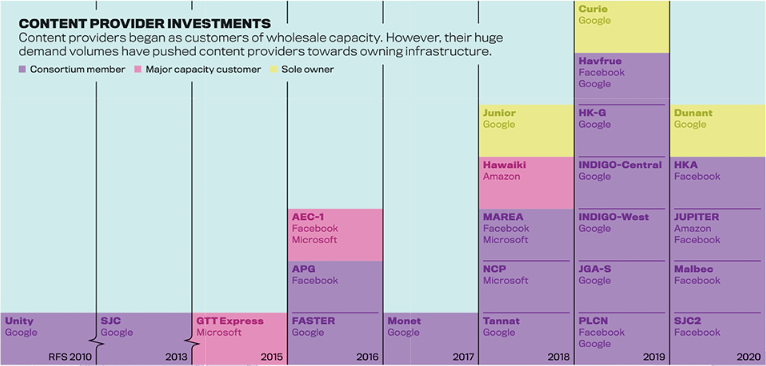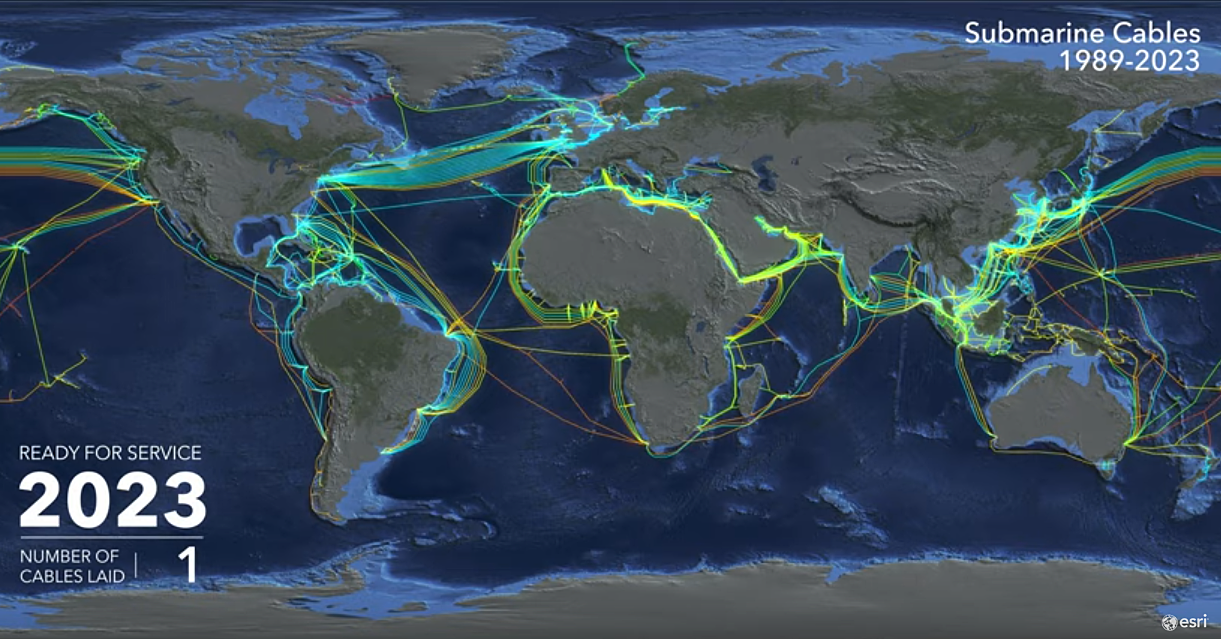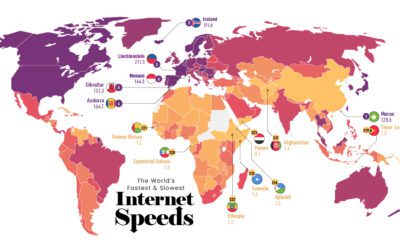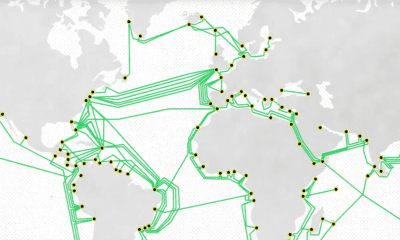Technology
Wired World: 35 Years of Submarine Cables in One Map
You could be reading this article from nearly anywhere in the world and there’s a good chance it loaded in mere seconds.
Long gone are the days when images would load pixel row by pixel row. Now, even high-quality video is instantly accessible from almost everywhere. How did the internet get so fast? Because it’s moving at the speed of light.
The Information Superhighway
The miracle of modern fiber optics can be traced to a single man, Narinder Singh Kapany. The young physicist was skeptical when his professors asserted that light ‘always travels in a straight line’. His explorations into the behavior of light eventually led to the creation of fiber optics—essentially, beaming light through a thin glass tube.
The next step to using fiber optics as a means of communication was lowering the cable’s attenuation rate. Throughout the 1960-70s, companies made gains in manufacturing, reducing the number of impurities and allowing light to cross great distances without a dramatic decrease in signal intensity.
By the mid-1980s, long distance fiber optic cables had finally reached the feasibility stage.
Crossing the Pond
The first intercontinental fiber optic cable was strung across the floor of the Atlantic Ocean in 1988. The cable—known as TAT-8*—was spearheaded by three companies; AT&T, France Télécom, and British Telecom. The cable was able to carry the equivalent of 40,000 telephone channels, a ten-fold increase over its galvanic predecessor, TAT-7.
Once the kinks of the new cable were worked out, the floodgates were open. During the course of the 1990s, many more cables hit the ocean floor. By the dawn of the new millennium, every populated continent on Earth was connected by fiber optic cables. The physical network of the internet was beginning to take shape.
As today’s video from ESRI shows, the early 2000s saw a boom in undersea cable development, reflecting the uptick in internet usage around globe. In 2001 alone, eight new cables connected North America and Europe.
From 2016-2020, over 100 new cables were laid with an estimated value of $14 billion. Now, even the most remote Polynesian islands have access to high-speed internet thanks to undersea cables.
*TAT-8 does not appear in the video above as it was retired in 2002.
The Shifting Nature of Cable Construction
Even though nearly every corner of the globe is now physically connected, the rate of cable construction is not slowing down.
This is due to the increasing capacity of new cables and our appetite for high-quality video content. New cables are so efficient that the majority of potential capacity along major cable routes will come from cables that are less than five years old.
Traditionally, a consortium of telecom companies or governments would fund cable construction, but tech companies are increasingly funding their own submarine cable networks.

Amazon, Microsoft and Google own close to 65% market share in cloud data storage, so it’s understandable that they’d want to control the physical means of transporting that data as well.
These three companies now own 63,605 miles of submarine cable. While laying cable is a costly endeavor, it’s necessary to meet surging demand—content providers’ share of data transmission skyrocketed from around 8% to nearly 40% over the past decade.
A Bright Future for Dark Fiber
At the same time, more aging cables will be taken offline. Even though signals are no longer traveling through this network of “dark fiber”, it’s still being put to productive use. It turns out that undersea telecom cables make a very effective seismic network, helping researchers study offshore earthquakes and the geologic structures on the ocean floor.
Brands
How Tech Logos Have Evolved Over Time
From complete overhauls to more subtle tweaks, these tech logos have had quite a journey. Featuring: Google, Apple, and more.

How Tech Logos Have Evolved Over Time
This was originally posted on our Voronoi app. Download the app for free on iOS or Android and discover incredible data-driven charts from a variety of trusted sources.
One would be hard-pressed to find a company that has never changed its logo. Granted, some brands—like Rolex, IBM, and Coca-Cola—tend to just have more minimalistic updates. But other companies undergo an entire identity change, thus necessitating a full overhaul.
In this graphic, we visualized the evolution of prominent tech companies’ logos over time. All of these brands ranked highly in a Q1 2024 YouGov study of America’s most famous tech brands. The logo changes are sourced from 1000logos.net.
How Many Times Has Google Changed Its Logo?
Google and Facebook share a 98% fame rating according to YouGov. But while Facebook’s rise was captured in The Social Network (2010), Google’s history tends to be a little less lionized in popular culture.
For example, Google was initially called “Backrub” because it analyzed “back links” to understand how important a website was. Since its founding, Google has undergone eight logo changes, finally settling on its current one in 2015.
| Company | Number of Logo Changes |
|---|---|
| 8 | |
| HP | 8 |
| Amazon | 6 |
| Microsoft | 6 |
| Samsung | 6 |
| Apple | 5* |
Note: *Includes color changes. Source: 1000Logos.net
Another fun origin story is Microsoft, which started off as Traf-O-Data, a traffic counter reading company that generated reports for traffic engineers. By 1975, the company was renamed. But it wasn’t until 2012 that Microsoft put the iconic Windows logo—still the most popular desktop operating system—alongside its name.
And then there’s Samsung, which started as a grocery trading store in 1938. Its pivot to electronics started in the 1970s with black and white television sets. For 55 years, the company kept some form of stars from its first logo, until 1993, when the iconic encircled blue Samsung logo debuted.
Finally, Apple’s first logo in 1976 featured Isaac Newton reading under a tree—moments before an apple fell on his head. Two years later, the iconic bitten apple logo would be designed at Steve Jobs’ behest, and it would take another two decades for it to go monochrome.
-

 Green1 week ago
Green1 week agoRanked: The Countries With the Most Air Pollution in 2023
-

 Automotive2 weeks ago
Automotive2 weeks agoAlmost Every EV Stock is Down After Q1 2024
-

 AI2 weeks ago
AI2 weeks agoThe Stock Performance of U.S. Chipmakers So Far in 2024
-

 Markets2 weeks ago
Markets2 weeks agoCharted: Big Four Market Share by S&P 500 Audits
-

 Real Estate2 weeks ago
Real Estate2 weeks agoRanked: The Most Valuable Housing Markets in America
-

 Money2 weeks ago
Money2 weeks agoWhich States Have the Highest Minimum Wage in America?
-

 AI2 weeks ago
AI2 weeks agoRanked: Semiconductor Companies by Industry Revenue Share
-

 Travel2 weeks ago
Travel2 weeks agoRanked: The World’s Top Flight Routes, by Revenue







